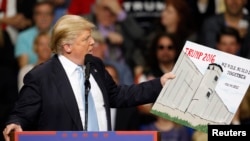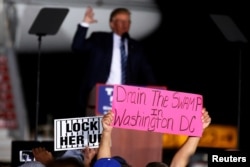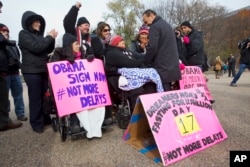In October, Donald Trump laid out his agenda for his first 100 days as president of the United States.
Responding to criticisms that his platform lacked specifics and solid plans, Trump laid out a list of proposals for what he wanted to accomplish once reaching the Oval Office.
Proposals were divided into three categories: measures to "clean up the corruption and special interest collusion" in Washington, actions to protect American workers, and restoration of security and the constitutional rule of law.
Additionally, Trump proposed 10 legislative measures he intended to work with Congress on, including repealing and replacing the Affordable Care Act, President Barack Obama's signature health care plan that expanded medical insurance to millions of Americans. Trump and other critics have said the plan of costs too much and provides inferior care. The controversial health care measure, known as Obamacare, was signed into law in 2010.
'Drain the swamp'
In the first category of his efforts to "drain the swamp" of Washington, Trump listed six initiatives, including tightening regulations on lobbyists.
The first of these six, imposing term limits on all members of Congress, would actually have to be initiated and approved by the Senate, because it would require a constitutional amendment. Constitutional amendments are proposed by Congress, not the president. Although Republicans hold a majority in both houses, it is still not clear how much support some of Trump's proposals will receive from Congress. Senate Majority Leader Mitch McConnell has already said he opposes term limits.
Another proposal on Trump's list is a hiring freeze on all federal employees to reduce the size of the federal workforce through attrition. This is most likely supported by Republican lawmakers, whose spending plans for years have called for reducing the number of non-national-security employees.
Of the seven proposals Trump made regarding the protection of American workers, three of them are related to the environment and U.S. energy policy, including approving construction of the controversial Keystone pipeline, canceling payments to U.N. climate change programs, and lifting restrictions on the production of shale oil, natural gas and clean coal.
Other proposals include rejecting the Trans-Pacific Partnership and renegotiating a number of other trade deals, including the North American Free Trade Agreement.
Trump listed five actions to restore "security and the constitutional rule of law," one of which is filling the Supreme Court seat held by the late Justice Antonin Scalia — an action Obama tried to take, only to be blocked by the Senate.
Cancel 'unconstitutional' orders
Other actions deal largely with immigration issues. The first proposal is to cancel all executive actions, memoranda and orders issued by Obama that Trump has labeled "unconstitutional." Of these, the Deferred Action for Childhood Arrivals program is one that could end, affecting protection for more than 1 million immigrants who were brought to the country as children.
Trump also stated his intention to remove undocumented immigrants with criminal records from the country, as well as suspend immigration from "terror-prone" countries from which he contends immigrants cannot safely be vetted.
Another is his proposal to build a wall on the U.S. border with Mexico, which he reaffirmed the Mexican government would ultimately pay for. Mexico's president told Trump in a meeting earlier this year that Mexico would not finance a wall.
The full transcript of Trump's speech in Gettysburg, Pennsylvania, that outlined his plan for his first 100 days in office can be seen here.
































